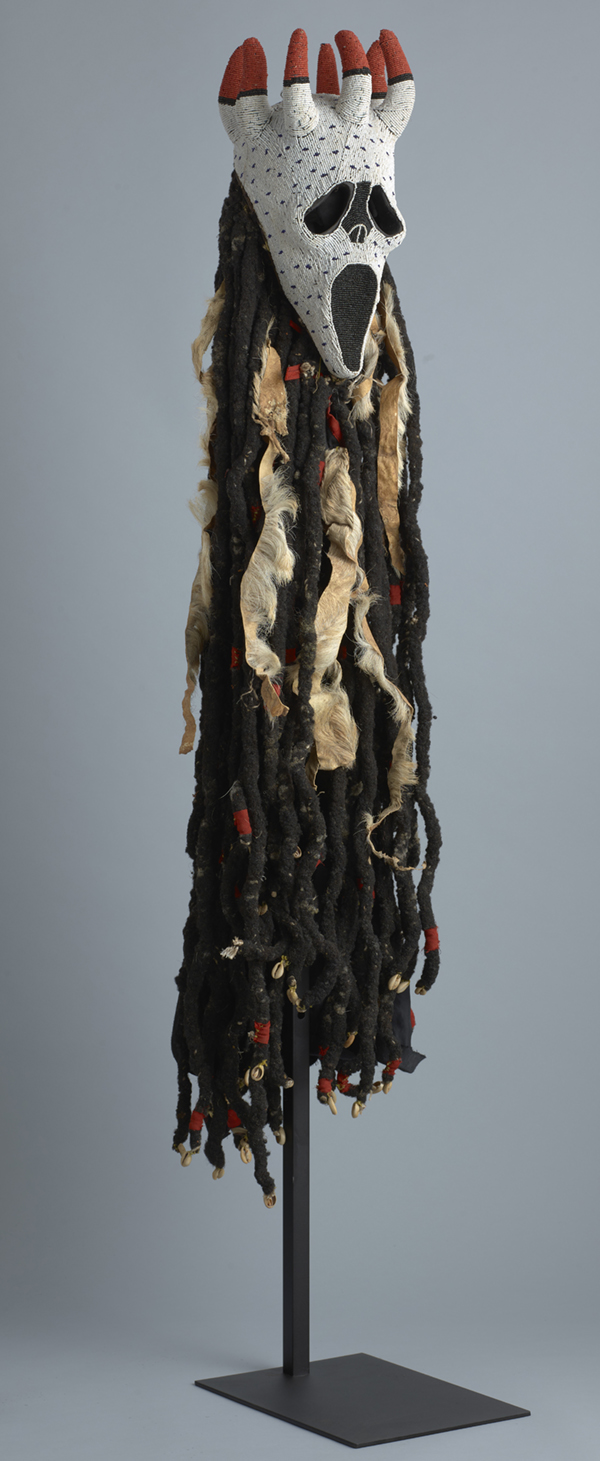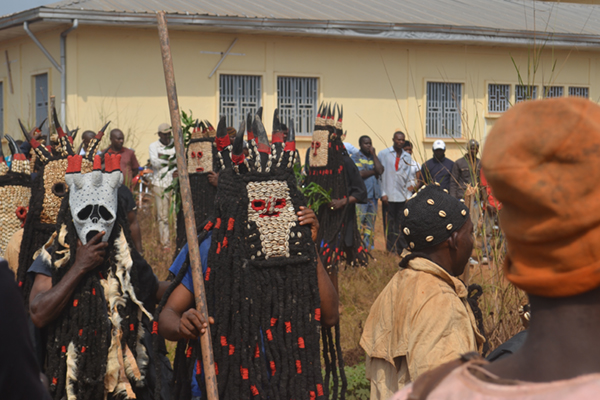Object of the Month: "Two-faced / Double Visage," 2015–2017, by Hervé Youmbi
By Bowdoin College Museum of Art
The multimedia installation piece Two-Faced / Double Visage (2015–2017) by the Cameroonian artist Hervé Youmbi (born 1973) features prominently in the exhibition Presence of the Past: Art from Central and West Africa. Currently on view online and in the Markell Gallery at the Museum of Art, the exhibition was curated by students in Professor David Gordon’s 2019 course “The Powers of Central African Art.” Only recently acquired by the Museum, Youmbi’s work provided an exciting opportunity for students to explore the historical and social themes of the course with a striking contemporary artwork. The themes of the Two-Faced / Double Visage are mirrored in the exhibition itself, both of which examine the history of West and Central African art and its complex reception and display in Europe and America.
Two-Faced / Double Visage is part of an ongoing series, Visages de Masques, by the artist. By combining traditional and modern forms and techniques, the works in this series challenge in both direct and subtle ways Western stereotypes about African art and distinctions between “traditional” and “contemporary” art from the African continent. At the heart of the dynamic, multimedia installation is a ceremonial mask entitled “Bamiléké Yegué Scream Mask” which blends traditional African and Western influences in striking ways. To create the mask, Youmbi collaborated with three local artist workshops in Cameroon, that of Alassane Mfouapon (carver), Frédéric Feudjeueck (coiffure), and Marie Kouam (beader). Though fashioned in partnership with artists employing traditional techniques, viewers will nonetheless recognize the imprint of modernity in Youmbi’s incorporation of the familiar “Ghostface mask” from the American horror film Scream (1996).
Like the history of African art "Bamiléké Yegué Scream Mask" critiques, the work has a multi-layered history of creation, ritual use, and exhibition. In 2016 the mask was ritually activated and performed by members of the Kun’ngang Society at society ceremonies. These dimensions are explored in compelling ways by the “ethnographic” field video, photograph, crate, and competing “art historical” and “ethnographic” labels authored by the artist that complete the multimedia installation and comment on its complexities. Together, these multimedia elements support Youmbi’s critical commentary on aesthetic and anthropological dynamics of the African art market and its historical relations to the “West.”
 The mask tradition that Youmbi’s work invokes is an important and prominent element of traditional art in Western and Central Africa and figured prominently in the reception of African art in Europe. In the early twentieth century African masks provided a source of inspiration among leading cubist and expressionist artists like Pablo Picasso, George Braque, and Amedeo Modigliani at the same time as art critics juxtaposed “primitive” African art against aesthetic traditions of the “civilized West.” Here, Youmbi has reversed the course of history by incorporating the “Ghostface mask” from the 1996 American horror film, Scream, which was in turn inspired by the 1893 icon of European modern art, Edvard Munch’s expressionist painting The Scream.
The mask tradition that Youmbi’s work invokes is an important and prominent element of traditional art in Western and Central Africa and figured prominently in the reception of African art in Europe. In the early twentieth century African masks provided a source of inspiration among leading cubist and expressionist artists like Pablo Picasso, George Braque, and Amedeo Modigliani at the same time as art critics juxtaposed “primitive” African art against aesthetic traditions of the “civilized West.” Here, Youmbi has reversed the course of history by incorporating the “Ghostface mask” from the 1996 American horror film, Scream, which was in turn inspired by the 1893 icon of European modern art, Edvard Munch’s expressionist painting The Scream.
Hervé Youmbi is one of the most exciting contemporary artists working in Cameroon today. His “postcolonial” mixed media and installation art critically engages the modern histories of Africa and the impact of colonialism and global capitalism on traditional and contemporary art from the continent. The Museum of Art looks forward to hosting a virtual program with the artist in April, where we will learn more about his practice and reflections on the past and future of art in Central Africa. Stay tuned for an announcement of this program.
Caption: A still from the “ethnographic” field video, a component of "Two-Faced / Double Visage Faces of Mask" series, 2015-2017, wood, hair, beads, hide, pigment, and cloth, by Hervé Youmbi, Cameroonian, born 1973. Museum Purchase, Lloyd O. and Marjorie Strong Coulter Fund. Bowdoin College Museum of Art. ©Hervé Youmbi
Sean P. Burrus
Andrew W. Mellon Postdoctoral Curatorial Fellow
Bowdoin College Museum of Art